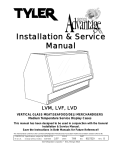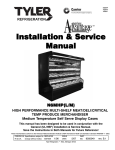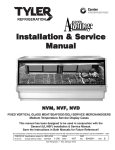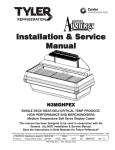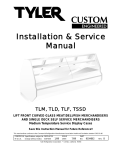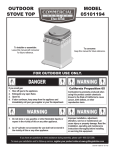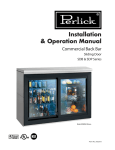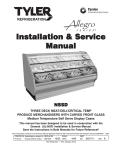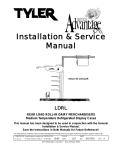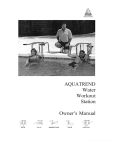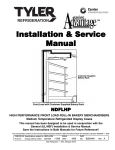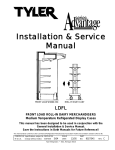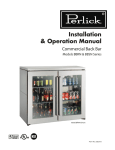Download Installation & Service Manual
Transcript
Installation & Service Manual LLBR, LLBN, LLBS LIFT FRONT CURVED GLASS BAKERY MERCHANDISERS Medium Temperature and Non-Refrigerated Bakery Display Cases This manual has been designed to be used in conjunction with the General Installation & Service Manual. Save the Instructions in Both Manuals for Future Reference!! This merchandiser conforms to the Commercial Refrigeration Manufacturers Association Health and Sanitation standard CRS-S1-96. PRINTED IN Specifications subject to REPLACES IN U.S.A. change without notice. EDITION 1/97 ISSUE DATE 7/99 Tyler Refrigeration Corporation * Niles, Michigan 49120 PART NO. 9027543 REV. B LLBR, LLBN, LLBS Tyler Refrigeration CONTENTS Page Specifications LLBR/LLBN/LLBS Specification Sheets . . . . . . . . . . . . . . . . . . . . . . 4 Line Sizing Requirements . . . . . . . . . . . . (See General I&S Manual) Pre-Installation Responsibilities . . . . . . . . . . . (See General I&S Manual) Installation Procedures Carpentry Procedures . . . . . . . . . . . . . . . . . . . . . . . . . . . . . . . . . 6 Case Line-Up . . . . . . . . . . . . . . . . . . . . . . . . . . . . . . . . . . . . . . . . 6 Lift Glass Leveling Instructions . . . . . . . . . . . . . . . . . . . . . . . . . . . . 7 Trim Installation . . . . . . . . . . . . . . . . . . . . . . . . . . . . . . . . . . . . . . . 8 Plumbing Procedures . . . . . . . . . . . . . . (See General I&S Manual) Refrigeration Procedures . . . . . . . . . . . (See General I&S Manual) Self-Contained Circuit (LLBS) . . . . . . . . . . . . . . . . . . . . . . . . . . . . . 9 Electrical Procedures . . . . . . . . . . . . . . . . . . . . . . . . . . . . . . . . . . 9 Electrical Considerations . . . . . . . . . . . . . . . . . . . . . . . . . . . . . . . . 9 Defrost Information . . . . . . . . . . . . . . . . . . . . . . . . . . . . . . . . . . . . 9 Defrost Control Chart . . . . . . . . . . . . . . . . . . . . . . . . . . . . . . . . . . . 9 Installation Procedure Check Lists . . . . (See General I&S Manual) Wiring Diagrams . . . . . . . . . . . . . . . . . . . . . . . . . . . . . . . . . . . . . . . . . . . 9 LLBR/LLBN Domestic & Export (50Hz) Case Circuits . . . . . . . . . . 10 LLBS Domestic & Export (50Hz) Case Circuits . . . . . . . . . . . . . . . 11 Cleaning and Sanitation Stainless Steel Cleaning Methods . . . . . . . . . . . . . . . . . . . . . . . . 12 General Information Rear Sliding Door Removal and Installation . . . . . . . . . . . . . . . . . 14 Page 2 October, 1996 Installation & Service Manual LLBR, LLBN, LLBS Page Service Instructions Preventive Maintenance . . . . . . . . . . . . (See General I&S Manual) Troubleshooting Self-Contained Units (LLBS) . . . . . . . . . . . . . . . . 15 Light Servicing . . . . . . . . . . . . . . . . . . . . . . . . . . . . . . . . . . . . . . 16 Ballast and Lighting Locations . . . . . . . . . . . . . . . . . . . . . . . . . . . 16 Fan Blade and Motor Replacement . . . . (See General I&S Manual) Color Band and Bumper Replacement . (See General I&S Manual) Lift Glass Replacement . . . . . . . . . . . . . . . . . . . . . . . . . . . . . . . 17 Lift Glass Cylinder Replacement . . . . . . . . . . . . . . . . . . . . . . . . 18 Lift Glass End Seal Replacement . . . . . . . . . . . . . . . . . . . . . . . . 19 Parts Information Operational Parts List . . . . . . . . . . . . . . . . . . . . . . . . . . . . . . . . . 19 Cladding and Trim Parts List . . . . . . . . . . . . . . . . . . . . . . . . . . . 19 TYLER Warranty . . . . . . . . . . . . . . . . . . . . . . . (See General I&S Manual) The following Medium Temperature (Remote & Self-Contained) and Non-Refrigerated Lift Front Glass Bakery Merchandiser models are covered in this manual: MODEL DESCRIPTION LLBR 59” & 77” LIFT FRONT GLASS REMOTE OPERATED BAKERY MERCHANDISER LLBN 59” & 77” LIFT FRONT GLASS NON-REFRIGERATED BAKERY MERCHANDISER LLBS 59” & 77” LIFT FRONT GLASS SELF-CONTAINED BAKERY MERCHANDISER January, 1997 Page 3 LLBR, LLBN, LLBS Tyler Refrigeration SPECIFICATIONS LLBR/LLBN/LLBS Lift Front Glass Service Merchandiser Specification Sheets Page 4 January, 1997 Installation & Service Manual LLBR, LLBN, LLBS LLBR/LLBN/LLBS Lift Front Glass Service Merchandiser January, 1997 Page 5 LLBR, LLBN, LLBS INSTALLATION PROCEDURES WARNING Tyler Refrigeration Carpentry Procedures Case Line-Up The raised front glass projects in front of the case and could cause personal injury to workers, operators and/or customers. Before starting the case line-up, review the store layout floorplans and survey the areas where case line-ups are going to be installed. • Do not remove orange warning tags from front edge of lift glass. WARNING • Do not leave lift glass raised and unattended. • Know where the front edge of the raised glass is when working near it. These cases are very heavy and require two or more people to move and/or position them. Improper handling of these cases could result in personal injury. 1. Snap chalk lines where the front and rear base rails of the case are to be located for the entire line-up. NOTE This case is designed so the front glass can be raised for cleaning and merchandising only. It is recommended that any cleaning or merchandising be done when the store is closed. If this is not possible, it should be done at a time when customer traffic is low. The raised glass should not be left unattended and should be lowered whenever leaving the case. The glass front is marked with orange warning tags to make it noticeable when in the raised position. Do not remove the orange warning tags. Page 6 Front and rear edges of base rails should always be used to line-up cases. 6” shims allow adjoining ends of cases to be shimmed together. 2. Locate highest point on chalk lines as a reference for determining the number of shims to be placed under the case base rails. Position first case at highest point on the chalk lines and shim case supports as required. Check leveling across the top of the case and on top of the color band. CAUTION If the base of this case is not sitting evenly on the floor, the case could warp when loaded and possibly break the lift glass. October, 1996 Installation & Service Manual LLBR, LLBN, LLBS NOTE CAUTION A foam gasket is factory installed on one end of the case. This gasket fits into a groove on the adjoining case when cases are pulled together. Do not depend on the foam gasket alone to make a good seal! Do not drill or use other holes through the case end for pull-ups. This may deform the case end and could cause joint leaks and/or poor refrigeration. 3. Apply two heavy beads of caulking compound from the Filler Kit to the end of case at dotted (. . .) and dashed (- - -) lines. Proper caulking provides good case refrigeration and sanitation. 4. Remove shipping tape from color band backer and bumper backer. 7. Position pull-up bolts and mounting hardware (5) at pull-up locations (A and B). Do not tighten any pull-up hardware until all of it has been installed. Tighten all pull-up hardware equally starting at point A and finishing at point B. Do not overtighten. Lift Front Glass Leveling Instructions Accurate leveling is critical for the proper operation of the lift glass on this case. In some instances, setting the case on an apparently level floor can cause the lift glass to fit improperly. If there is any twist in the body, it could cause the lift glass not to fit or work properly. 5. Push cases tightly together making sure the pull-ups are aligned. The emphasis when leveling this case must be on making sure the lift glass works and seals properly. 6. Add shims (1), as required, under the adjoining case base rails (2). Check leveling at top of the case (3) and on top of the color band (4). October, 1996 Page 7 LLBR, LLBN, LLBS Tyler Refrigeration removed. Pre-prime the cylinders by gently lifting the front glass approximately 6”, then close. Repeat this movement at least 4 or 5 times before fully opening the lift glass. The case should be leveled across the top, close to the hinge, and on the color band. A 4 foot level is recommended, and both places should be level! This will enable the lift glass to fit and work properly. If the lift glass still doesn’t close or line-up properly, add shims to case corners. Shimming will ensure proper operation and alignment of the lift glass. NOTE If the glass does not stay in the open position, see “Lift Glass Cylinder Replacement” in this manual. Trim Installation The handle on the lift glass must rest evenly on the color band. Proper lift glass sealing is essential for good product refrigeration. NOTE Do not anchor the base to the floor or enclose the case until the lift glass is fitting properly and working correctly. Pre-priming the hinge gas cylinders: WARNING If the front glass is raised before the hinge gas cylinders are pre-primed, the glass could break and/or cause personal injury. After the case has been installed and leveled, make sure the shipping braces have been Page 8 The joint trim and mounting hardware are shipped loose. Trim includes top joint trim (1), rear upper joint trim (2), rear base joint trim (3) and horizontal joint trim (4). October, 1996 Installation & Service Manual Horizontal joint trim covers gaps between the cases. The trim is glued onto the shipping cardboard. It is applied after running beads of caulking on the edges of the cases. Sheet metal screws or pop-rivets can be used for additional securing. Patch end trim is shipped factory installed. If field installation is required, be sure the patch end is pulled up enough to fit snuggly against the sealing tubing on the inside of the case. The patch end must seal tightly against the lift glass wiper to ensure proper operating temperatures. LLBR, LLBN, LLBS Fluorescent Lamp Circuit LLB(R/N/S) case lighting is supplied by 200MA T-6 lights. It is controlled by a light switch in each case. The standard lighting is 2 rows of horizontal canopy lights. Defrost Information See “General I&S Manual” for operational descriptions for each type of defrost control. Defrost Control Chart LLBR/LLBS Defrost Option Settings Refrigeration Procedures Defrost Defrost Defrosts Duration Per Day (Min) Type Off Time 1 45 Refrigeration system and superheat instructions can be found in the “General I&S Manual”. Thermostat bulb is located under the rear duct, 24” from the right end of the evaporator coil. Self-Contained Circuit (LLBS Only) WIRING DIAGRAMS See “General I&S Manual” for bumper and color band installation and alignment. LLBS cases are self-contained units. Information pertaining to self-contained units should be obtained directly from TYLER Refrigeration. Electrical Procedures Electrical Considerations CAUTION Make sure all electrical connections at components and terminal blocks are tight. This prevents burning of electrical terminals and/or premature component failure. Term. Temp. ----- ELECTRICIAN NOTE - OVERCURRENT PROTECTION 120V circuits should be protected by 15 or 20 Amp devices per the requirements noted on the cabinet nameplate or the National Electrical Code, Canadian Electrical Code - Part 1, Section 28. 208V defrost circuits employ No. 12 AWG field wire leads for field connections. On remote cases intended for end to end line-ups, bonding for ground may rely upon the pull-up bolts. The following pages 10 and 11 show wiring diagrams for case and lighting circuits NOTE The ballast box is located at the lower left rear corner of the case. It houses ballasts and terminal blocks. Case Fan Circuit (LLBR/LLBS) This circuit is to be supplied by an uninterrupted, protected 120V circuit. The case fan circuit is not cycled on this case. October, 1996 Page 9 Page 10 October, 1996 January, 1997 Page 11 LLBR, LLBN, LLBS Tyler Refrigeration CLEANING INSTRUCTIONS WARNING TYLER Refrigeration does not recommend the use of high pressure cleaning equipment on service style cases!! The sealing of front glass and end joints is critical in these cases and high pressure cleaners can penetrate and/or damage these seals. Damaged seals allow water leaks and/or air leaks that can cause poor case refrigeration. CAUTION • When cleaning this case, try not to introduce water into the case faster than it can be carried away by the waste outlet. • Always use a soft cloth or sponge with mild detergent and water to clean the front glass. Never use abrasives or scouring pads to clean glass. They can scratch and/or damage the glass. See “General I&S Manual” for case cleaning instructions. Stainless steel cleaning is covered in the following chart. Stainless Steel Cleaning Methods The cleaning data in the following stainless steel cleaning chart was supplied by AISI. The information was supplied by Prime Metals Division, Alumax Aluminum Corporation. TYPE OF CLEANING CLEANING AGENT* APPLICATION METHOD** EFFECT ON FINISH Routine cleaning Soap, ammonia or detergent and water. Sponge with cloth, then rinse with clear water and wipe dry. Satisfactory for use on all finishes. Smears and fingerprints Arcal 20, Lac-O-Nu, Lumin Wash O’Cedar Cream Polish, Stainless Shine Rub with cloth as directed on the package. Satisfactory for use on all finishes. Provides barrier film Apply with damp sponge or cloth. Satisfactory for use on all finishes. Rub with damp cloth. Satisfactory for use on all finishes if rubbing is light. Grade FFF Italian pumice, whiting or talc Rub with damp cloth. Use in direction of polish lines on No. 4 (polished) finish. May scratch No. 2 (mill) and No. 7 and 8 (polished) finishes. Liquid NuSteel Rub with dry cloth. Use a small amount of cleaner. Use in direction of polish lines on No. 4 (polished) finish. May scratch No. 2 (mill) and No. 7 and 8 (polished) finishes. Paste NuSteel or DuBois Temp Rub with dry cloth. Use a small amount of cleaner. Use in direction of polish lines on No. 4 (polished) finish. May scratch No. 2 (mill) and No. 7 and 8 (polished) finishes. Cooper’s Stainless Steel Cleaner, Revere Stainless Steel Cleaner Apply with damp sponge or. cloth. Use in direction of polish lines on No. 4 (polished) finish. May scratch No. 2 (mill) and No. 7 and 8 (polished) finishes. Household cleaners (Old Dutch, Lighthouse, Sunbrite, Wyandotte, Bab-O, Gold Dust, Sapolio, Bon Ami, Ajax or Comet.) Rub with a damp cloth. May contain chlorine bleaches. Rinse thoroughly after use. Bleaches, left on surfaces, may lead to corrosion. Use in direction of polish lines on No. 4 (polished) finish. May scratch No. 2 (mill) and No. 7 and 8 (polished) finishes. Stubborn spots and Allchem Concentrated stains, baked-on Cleaner splatter, and other light discolorations Samae, Twinkle, or Cameo Copper Cleaner Page 12 July, 1999 Installation & Service Manual TYPE OF CLEANING CLEANING AGENT* LLBR, LLBN, LLBS APPLICATION METHOD** EFFECT ON FINISH Grade F Italian pumice, Steel Rub with a damp cloth. Bright, Lumin Cleaner, Zud, Restoro, Bon Ami, Ajax or Comet Use in direction of polish lines on No. 4 (polished) finish. May scratch No. 2 (mill) and No. 7 and 8 (polished) finishes. Penny-Brite or Copper-Brite Rub with a dry cloth. Use a small amount of cleaner. Use in direction of polish lines on No. 4 (polished) finish. May scratch No. 2 (mill) and No. 7 and 8 (polished) finishes. Penny-Brite or Copper-Brite Rub with a dry cloth. Use in direction of polish lines on No. 4 (polished) finish. May scratch No. 2 (mill) and No. 7 and 8 (polished) finishes. Paste NuSteel or DuBois Temp Rub with dry cloth. Use a small amount of cleaner. Use in direction of polish lines on No. 4 (polished) finish. May scratch No. 2 (mill) and No. 7 and 8 (polished) finishes. Revere Stainless Steel Cleaner Apply with a damp sponge or cloth. Use in direction of polish lines on No. 4 (polished) finish. May scratch No. 2 (mill) and No. 7 and 8 (polished) finishes. Allen Polish, Steel Bright, Wyandotte, Bab-O or Zud Rub with a damp cloth. Use in direction of polish lines on No. 4 (polished) finish. May scratch No. 2 (mill) and No. 7 and 8 (polished) finishes. Burnt-on foods and grease, fatty acids, milkstone (where swabbing or rubbing is not practical) Easy-Off, De-Grease-It, 4-6% hot solution of such agents as trisodium tripolyphospate, or 5-15% caustic soda solution Apply generous coating. Allow to stand for 10-15 min. Repeated application may be necessary. Excellent removal, satisfactory for use on all finishes. Tenacious deposits, rusty discolorations, industrial atmospheric stains Oakite No. 33, Dilac, Texo 12, Texo N.Y., Flash-Klenz, Caddy Cleaner, Turco Scale 4368 or Permag 57. Swab and soak with clean cloth. Let stand 15 minutes or more according to directions on package. Rinse and dry. Satisfactory for use on all finishes. Hard water spots and scale Vinegar Swab or wipe with a cloth. Rinse with water and dry. Satisfactory for use on all finishes. 5% oxalic acid, 5% sulamic acid, 5-10% phospheric acid, or Dilac, Oakite No. 33, Texo 12 or Texo N.Y. Swab or soak with a cloth. Let stand 10-15 minutes. Always follow with neutralizer rinse, and dry. Satisfactory for use on all finshes. Effective on tenacious deposites or where scale has built up. Organic solvents such as carbon tetrachloride, trichlorethylene, acetone, kerosene, gasoline, benzene, alcohol and chlorethane n.u. Rub with a cloth. Organic solvents may be flammable and/or toxic. Observe all precautions against fire. Do not smoke while vapors are present. Be sure area is well ventilated. Satisfactory for use on all finishes. Heat tint or heavy discoloration Grease and oil * Use of proprietary names is intended only to indicate a type of cleaner, and does not constitute an endorsement, nor is omission of any proprietary cleanser to imply its inadequacy. It should be emphasized that all products should be used in strict accordance with instructions on package. ** In all applications a stainless steel wool or sponge or fibrous brush or pad are recommended. Avoid use of ordinary steel wool or steel brushes for scouring stainless steel. October, 1996 Page 13 LLBR, LLBN, LLBS Tyler Refrigeration GENERAL INFORMATION Rear Sliding Door Removal and Installation The sliding doors come installed from the factory in the door frame. These doors are removable for cleaning and to aid in case maintenance. NOTE: DO NOT FULLY IMMERSE DOORS WHEN CLEANING. The inner and outer doors are marked with labels from the factory. If the doors are not labeled, the inner door can be identified as having the limiter stops on it. 1. Remove the outer door (1) by sliding it to the right end of the door frame (2) (within an inch of being closed). 3. Tilt out the bottom of the outer door (1) so it can clear the lower track (4). 4. Lower the outer door (1) out of the upper track (3) to remove it from the case. 5. Repeat steps 1 thru 4 to remove the inner door (5). 6. Reverse the above steps to replace the inner and outer doors (5 and 1). 2. Firmly grasp both sides of the outer door (1) and lift into the upper track (3) until it clears the lower track (4). Page 14 July, 1999 Installation & Service Manual LLBR, LLBN, LLBS SERVICE INSTRUCTIONS Troubleshooting Self-Contained Units (LLBS Only) WARNING Never work on electrically powered equipment while it is energized! Electrical shock could cause personal injury and/or death. TROUBLE COMMON CAUSE REMEDY 1. Unit will not run Blown fuse Replace fuse. Low voltage Check outlet with voltmeter. Voltage should be 115V or 220V (±10%). Inoperative motor or temperature control Check connections. Shelves overloaded; blocked air flow Make sure items do not block the air flow. Thermostat set incorrectly Check setting. Pressure control set incorrectly Check setting. Case fans not operating Check terminal block connections. Thermostat set incorrectly Check setting. Pressure control set incorrectly Check setting. Inadequate air circulation Relocate cabinet or remove obstruction. Check installation requirements. Room temperature too warm Ventilate room appropriately. Thermostat set incorrectly Reset thermostat. Refrigerant charge low Have unit serviced by a qualified service technician. Loose baffles Tighten or brace baffles. Tubing contacting cabinet or other tubing Move tubing. Cabinet not level Level cabinet. 6. Frost or ice on evaporator coil Defrost clock doesn’t work Check electrical conections. Have unit serviced by a qualified service technician. 7. Water dripping from case drain Condensate drain clogged Clear drain. Dissipator not functioning Check electrical supply. Check float assembly. 2. Refrigerated section is too warm 3. Refrigerated section too cold 4. Unit runs all the time 5. Noisy operation October, 1996 Page 15 LLBR, LLBN, LLBS Light Servicing Tyler Refrigeration Ballast Installation See “General I&S Manual” for lamp, fan blade and motor (LLBR/LLBS only), and color band and bumper replacement instructions. Ballast and Lighting Locations All light ballasts are located in the electric box on the left end of the rear of the case. In order to retain safety approval with Underwriters Laboratory and the Canadian Standards Association, the mounting of electrical components and interconnecting wires must not deviate from the following instructions. Only qualified personnel are authorized to install the accessory items. TYLER Refrigeration recommends you order all component parts from its Service Parts Department. 1. Remove cover from electric box (1) located on the left rear side of the case. NOTE If tappit screws are not available, a starwasher should be used between the ballast and the heads of the screws. 2. Install required number of ballasts (2) in electric box (1) with two screws (3) each. 3. Identify and connect required wiring harnesses (upper, lower, etc...) to the ballast connectors (4). 4. Replace cover on electric box (1). Page 16 October, 1996 Installation & Service Manual LLBR, LLBN, LLBS Lift Glass Replacement WARNING Wear safety glasses and gloves and use at least two people when replacing glass. Glass is heavy and weight distribution is uneven. Mishandling of glass could cause breakage and/or personal injury. 1. Make sure the lift glass is in the fully open position or the glass frame clamp (1) is in the up position. 2. While holding glass, remove four screws (2) from hinges (3), shims (4) and glass frame clamp (1). 3. Replace broken lift glass assembly (5) with new lift glass assembly (5). Make sure to replace the shims that were removed during disassembly.. 4. Install four screws (2) in hinges (3) and glass frame clamp (1). Tighten each hinge screw (2) to 60 lb-in. of torque. Do not overtighten. January, 1997 5. Check torque of glass frame clamp setscrews. It should be pre-torqued to 48 lb-in. Do not overtighten. NOTE Lift glass must seal tightly to ensure proper operating temperatures! Replacement seals are available through TYLER Service Parts. 6. After the lift glass has been replaced, install the end seal trim following the instructions on page 19. Close the lift glass. Make sure the lift glass seals tightly against the color band. Page 17 LLBR, LLBN, LLBS Lift Glass Cylinder Replacement Tyler Refrigeration WARNING All product should be removed from the case and the surrounding area before making this repair. Failed cylinders will not support the glass sufficiently to allow repeated opening and closing. Do not attempt to open the glass until the defective cylinder can be replaced. Failure to comply could cause glass breakage and/or personal injury. 1. Remove the lift glass by following the instructions on the previous page. 5. Remove and replace the defective cylinder in the pivot hinge assembly (1). 2. Mark the position of the pivot hinge assembly (1) on the top interior of the case. 6. Position pivot hinge assembly (1) inside top of case (4) as marked during removal and secure with four screws (3). After rechecking the hinge positioning, tighten the four screws (3) to 55 lb-in. of torque. NOTE 3. Drill out rivets and remove the stainless steel top cover (2). 4. Remove four screws (3) from top of case (4) and remove the pivot hinge assembly (1) from the inside top of the case (4). Page 18 7. Install stainless steel top cover (2) and secure with rivets. 8. Install the lift glass by following the instructions on the previous page. January, 1997 Installation & Service Manual Lift Glass End Seal Replacement The end seal trim for the curved glass edge is designed to slide on the glass without the need for glue or other adhesives. Looking at the cross section, you will notice a slight protrusion on the underside of the trim. This protrusion helps prevent the seal trim from coming off the glass once the trim piece has been properly installed. LLBR, LLBN, LLBS 4. Cut off any excess end seal trim that extends beyond the bottom edge of the glass. Close the lift glass. 1. Lift the glass to the fully opened position. 2. Thoroughly clean the edge of the glass (1) and the end seal trim (2) by wiping with alcohol. Dry both surfaces. 3. Starting at the top edge of the glass (1), push on the end seal trim (2) with the protrusion lip against the inside glass surface. PARTS INFORMATION Operational Parts List Case Usage Domestic Electrical Circuit 115 Volt 60 Hertz Case Size 59” 77” Primary Fan Motor (LLBR/LLBS) 5125532 5 Watt 5125532 5 Watt Primary Fan Motor Brackets (LLBR/LLBS) 5962269 5962269 Primary Fan Blades (7” 15° 5B) (LLBR/LLBS) 5223891 5223891 Vent Fan Motor (LLBR/LLBS) 5120747 5120747 Vent Fan Blades (3” 4B) (LLBR/LLBS) 5120748 5120748 200MA Ballast (canopy) 5235876 5235266 T-6 Lampholder (telescopic) 5236168 5236168 5236169 5236169 5940375 5940375 (stationary) Thermostat (LLBR/LLBS) For information on operational parts not listed above contact the TYLER Service Parts Department. October, 1996 Page 19 LLBR, LLBN, LLBS Tyler Refrigeration Cladding and Trim Parts List Item Description LLBR/LLBN/LLBS 59” 77” 1 Seal (250’) 5233454 5233454 2 Bumper Retainer 9025048 9025055 3 Screw 9025833 (9) 9025833 (9) 4 Color Band, Painted 9026400 9026401 5 Color Band Backer, Painted 9026432 9026432 6 Bumper Backer ---- color by order ---- 7 Bumper ---- color by order ---- 8 Upper Front Cladding, Painted 9026377 9026378 9 Rivet 5104702 5104702 10 Screw 5183536 (20) 5183536 (20) 11 Lower Front Cladding, Painted 9026379 9026380 12 Kickplate Kickplate Backer ---- color by order ---9041790 9041790 13 Screw 5183536 (4) 5183536 (6) 14 Kickplate Support 9041329 (2) 9041329 (3) 15 Screw 5100217 (3) 5100217 (3) 16 LH End Closeoff, Painted 9022468 9022468 17 RH End Closeoff, Painted 9022467 9022467 18 Horizontal End Trim 5211585 5211585 19 Rear Base Joint Trim 5233638 5233638 20 Screw 5619204 (4) 5619204 (4) 21 Upper Rear Joint Trim 5235948 5235948 22 Screw 5619204 (4) 5619204 (4) 23 Top Joint Trim, BR/SS 5235953 5235953 24 Screw 5619204 (2) 5619204 (2) Page 20 July, 1999 Installation & Service Manual July, 1999 LLBR, LLBN, LLBS Page 21





















